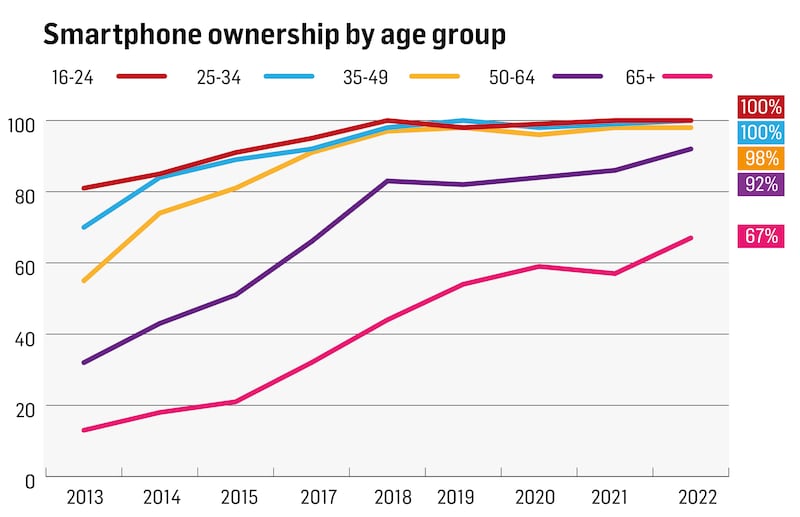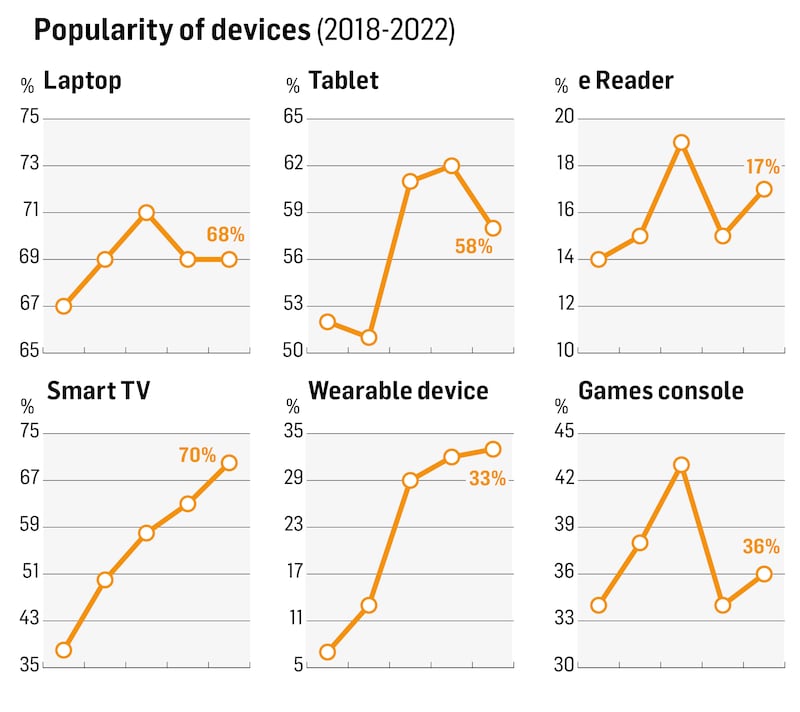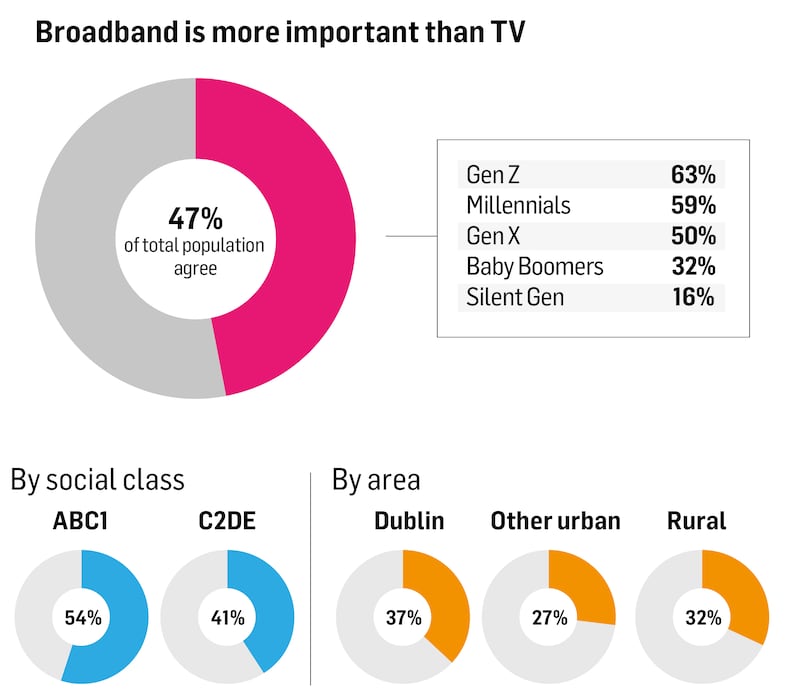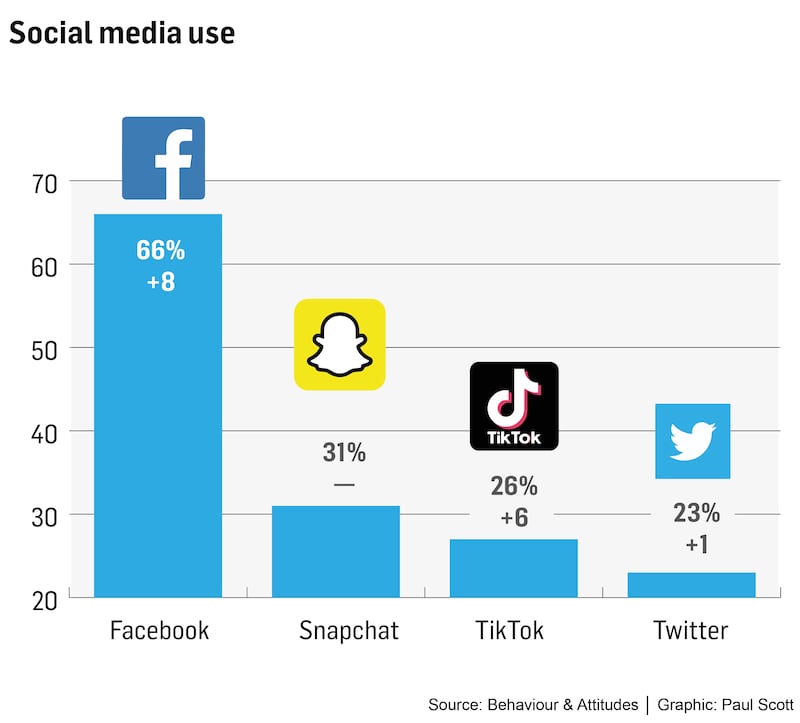TikTok has overtaken Twitter in the Irish social media popularity stakes, but Facebook and Instagram still dominate. Remote working may be here to stay, but that’s more likely if you are in Dublin than elsewhere. And while we have been making moves to disconnect from screens, the popularity of connected devices continues to rise as we bring more of them into our homes.
The Behaviours and Attitudes 2022 Techscape report outlines some of the developments in the tech scene in the past year as the digitalisation of Irish society picks up pace. But it also warns about a lack of access for some sectors of society due to a combination of location and age, with a third of people aged 65 and over saying they never go online. The digitalisation of finance and telecoms sectors is likely to present difficulties for this group of people, the report finds.



The average Irish home now has access to eight smart devices – laptops, tablets, wearables, e-readers and so on – although that was higher among those from a middle-class background, people who live in Dublin and people who are either at the pre-family stage or have teenagers in the house. Those aged between 16 and 24 had access to more than 11 devices, a figure that dropped to under seven for those in the 50-64 age group, and to under four for those over 64 years of age.
The type of smart devices people have is also changing. Tablet and laptop ownership has fallen slightly, at 58 per cent and 68 per cent respectively, but 70 per cent of people own a smart TV, up from 36 per cent in 2018. The ownership of smart hubs, such as Amazon’s Alexa-enabled Echo devices and Google Home speakers, has also continued to climb – at 31 per cent this year compared with 25 per cent in 2021 and 16 per cent in 2019.
READ MORE
Obsessions with popular video games such as Animal Crossing may have abated slightly as the economy opened up and Covid-19 measures were relaxed. Although games console ownership has risen slightly from last year’s 34 per cent to 36 per cent, it still lags the peak of 43 per cent logged in February 2020, at the beginning of the coronavirus pandemic.
[ What is TikTok and who is it aimed at?Opens in new window ]
Despite recent moves to disconnect and the interest in more simple “feature” phones, smartphones remain popular, with 92 per cent of people saying they owned such a device. Ownership was high among Gen Z (born 1997-2005), Millennials (1978-1996) and Gen X (1966-77), with all under-50s that owned a phone having one that was classed as a smartphone. Among the over-50s, smartphone use is rising, with 83 per cent of Baby Boomers (born 1947-1965) said they owned one. That figure drops to 58 per cent among the so-called ‘Silent Gen’, those born before 1946.
In social media, the landscape has shifted a little, with relative newcomer TikTok challenging the more established services. While Facebook is still a behemoth on the social media scene, video platform TikTok has been making some progress, and is now more popular than Twitter. Perhaps benefitting from the pandemic surge in interest, ByteDance-owned TikTok has seen its popularity climb in the past couple of years, gaining 6 per cent over last May. That compares to a 1 per cent gain for Twitter, a 2 per cent increase for Instagram and an 8 per cent climb for Facebook. Snapchat was static.
If we have trouble sleeping, we are more likely to pick up our phone to pass the time, with a third of people with social media accounts admitting to the behaviour. However, the number of people checking their emails, social media or messages first thing in the morning and last thing at night has also declined, pointing to a wider trend towards switching off. Gen Z are also more likely to try to do a social media detox, at 40 per cent compared to an average of 29 per cent.



There is also a gap in the attitudes towards broadband. High-speed internet connections were much more important to younger users than those in the older age groups. Overall just under half of the population agreed that broadband was more important than TV to them, but that figure was significantly higher among the Gen Z population, at 63 per cent and Millennials at 59 per cent. While Gen X was evenly divided at 50 per cent, only 32 per cent of Baby Boomers agreed with the statement, and a mere 16 per cent of over-64s feel their broadband is more important than TV.
One of the factors that may be influencing that is the use of streaming TV services. Younger users are much more likely to have streaming services and devices available to them, with the younger users favouring YouTube, Netflix and Twitch. Although it doesn’t appear that people are abandoning Netflix yet, that may change as the cost of living increases and price hikes by Netflix hit users, forcing them to make choices about where their money goes. The streaming service said itself it expects to shed even more customers in the coming months as competition heats up in the streaming sector.
One of the more surprising findings may be around remote working, with about one in five people working from home two or more days a week. Although rural users are starting to register more highly on this, it is still a middle class, Dublin-centric trend, according to the survey, with those in the 25-49 age group more likely to have flexible arrangements.










